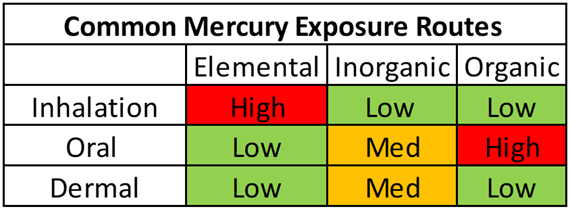Published on February 27, 2019
D*action Magnesium + Safety is a new project from GrassrootsHealth to provide you with information about your nutrient status for many essential elements and toxins. In previous blogs we discussed what magnesium is, why it’s important for health, and how magnesium status is assessed. We also previously discussed the other essential elements in the new testing panel (selenium, zinc, and copper) and the first heavy metal toxic elements (cadmium and lead). Today we will review the health effects of exposure to mercury, the third heavy metal toxic element in the new testing panel.
What is Mercury?
 Mercury is one of the most toxic heavy metals and is found in water, air, and soil. Mercury exists in multiple forms including elemental mercury, inorganic mercury, and methylmercury. Elemental, or metallic, mercury has been used in batteries, fluorescent light bulbs, thermometers, and dental amalgams and can be emitted into the air during the burning of fossil fuels. Inorganic mercury can be found in mercuric chloride (mainly used for industrial processes and making chemicals) and has historically been used in photography, specimen preservation, and for the treatment of diseases such as syphilis before antibiotics were discovered. Microscopic organisms can convert elemental and inorganic mercury to methylmercury, an organic form of mercury, which then accumulates in the food chain (particularly in certain types of fish). Ethylmercury is another type of organic mercury that is more quickly cleared from the body than methylmercury and has been used as a preservative, such as thimerosal in some vaccines.
Mercury is one of the most toxic heavy metals and is found in water, air, and soil. Mercury exists in multiple forms including elemental mercury, inorganic mercury, and methylmercury. Elemental, or metallic, mercury has been used in batteries, fluorescent light bulbs, thermometers, and dental amalgams and can be emitted into the air during the burning of fossil fuels. Inorganic mercury can be found in mercuric chloride (mainly used for industrial processes and making chemicals) and has historically been used in photography, specimen preservation, and for the treatment of diseases such as syphilis before antibiotics were discovered. Microscopic organisms can convert elemental and inorganic mercury to methylmercury, an organic form of mercury, which then accumulates in the food chain (particularly in certain types of fish). Ethylmercury is another type of organic mercury that is more quickly cleared from the body than methylmercury and has been used as a preservative, such as thimerosal in some vaccines.
What are the most common ways people are exposed to Mercury?

Exposure to small amounts of methylmercury is common because a majority of fish and shellfish contain trace amounts. However, mercury levels in most people are very low and not associated with possible adverse health outcomes. The consumption of larger, older fish such as swordfish, king mackerel, tilefish, and shark can result in higher methylmercury exposure because these fish have accumulated higher levels of mercury. Since methylmercury can pass through the placenta, pregnant women should avoid eating these types of fish. Exposure to elemental mercury can happen if a container, product, or device containing mercury breaks. Elemental mercury is a liquid at room temperature and can evaporate into an odorless toxic vapor that is inhaled if it is not immediately cleaned up. Additional potential exposure to elemental mercury includes breaking of a mercury containing thermometer, jewelry with glass pendants containing mercury, dental amalgams (“silver” dental fillings), and small-scale gold mining. Exposure to inorganic mercury can happen if a person works where inorganic mercury compounds are used or when using products manufactured abroad that contain mercury, such as some skin-lightening creams and anti-aging products.
What are the potential health effects of Mercury?
Potential health effects of mercury exposure depends on many factors including the form of mercury, amount and length of exposure, route of exposure (see chart below). Those exposed to high levels of methylmercury, a neurotoxin, can experience muscle weakness, loss of coordination, tingly feeling, loss of peripheral vision, and loss of speech and hearing. Exposure to methylmercury is particularly harmful during fetal development in the womb and in infants because their brains and nervous systems are more readily affected than those of adults. In utero exposure can lead to problems with memory, attention, language, cognitive thinking, fine motor and visual spatial skills. Inhaling elemental mercury can cause lung damage, headaches, insomnia, emotional or neuromuscular changes, and tremors. Very high exposure to elemental mercury can cause kidney and respiratory problems and sometimes death. High exposure to inorganic mercury can cause skin rashes, memory loss, muscle weakness, mood swings and damage to the nervous system, kidneys and gastrointestinal tract. Additionally, since mercury has a high affinity to selenium, these two elements can bind tightly which reduces the toxicity of mercury but can lead to diseases caused by selenium deficiency, such as thyroid disease.

Source: ZRT Laboratory
What does a blood spot test tell you about your Mercury exposure?
A dried blood spot test is an indicator of recent exposure to organic mercury (methylmercury or ethylmercury). The range of the average population the lab serves (reference range) is less than 5.29 micrograms per liter (μg/L). For elemental and inorganic mercury, a urine test is a better indicator of exposure.
Order your D*action Magnesium + Safety test TODAY! — includes Mercury test
Use code EndOfWinter for free shipping on this kit
(expires 3/5/19)
How can I track my Mercury levels?
To help you track your toxin levels, GrassrootsHealth has created an online tracking system called myData-myAnswers. This will help you know how your toxin levels impact your health. Check it out today!








